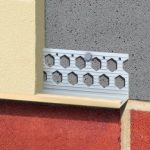Renders have many uses, they are not used solely on their ability to make a property look more attractive. Many renders are not only designed to be used on parts of a building where there is a damp course, but may be used in older properties. Older buildings may not have a damp proofing course (a horizontal, waterproof barrier in a wall) because they have thick walls, a masonry core and brick or stone exteriors. Walls of older houses were designed to absorb water from rising damp. However, the old house walls do not always absorb water from rising damp and so damp proofing renders are required in these circumstances. If the old, outer walls have a render of sand and cement then this needs removing. When the original render has been replaced, a lime and aggregate mortar or lime material is used as a damp proofing renders.
When applying damp proofing renders, it is advisable to use lime based paints because the lime component allows moisture to pass freely in and out of the surface to be rendered whereas modern masonry paint create an impermeable barrier that prevents water vapour from leaving the walls. For more modern properties there are now specially designed rendering materials that will protect your home from the problems caused by damp for many years.
Damp proofing renders for interior walls means removing any bitumen and replacing it with a lime render and paint that is breathable. Damp proofing renders may not have an immediate effect on walls that have been damp for years because it can take between six and twelve months for the walls underneath the damp proofing render to dry out. Lime renders should be applied by a qualified professional for maximum efficiency because lime is a building material that requires skill and experience to use. In more modern homes where a damp proof course (a horizontal, waterproof barrier in a wall) exists it should not be rendered over as it can cause rising damp and could invalidate the certificate you had with your damp course. If you are going to have exterior walls rendered and there is a damp proof course then you should use a bell cast (a piece of equipment that forms and protects the lower edge of external render, see Fig.1) about a couple of inches above the damp course and render over that which means the damp course will still be able to work.
Fig.1: An example of a bell cast bead
Some heavy duty coverings protect your exterior walls from moisture and act as damp proofing renders. Once a wall is coated in a particular product the wall is then sealed against penetrating damp. Damp brickwork and crumbling walls can be dealt with effectively by damp proofing renders that will enhance the look of your home while protecting it from damp and making it more weatherproof. A waterproofing textured render can protect your home from damp for up to twenty years. If your house has a cellar then there are cellar renderings that can protect your basement from damp. Some damp proofing renders are cement based and these are either sprayed on or put on with a trowel, depending on the size of the area that needs rendering. Some renders set so that they form a bond with the masonry substrata and create a barrier to rising damp.